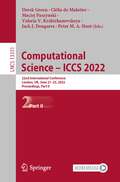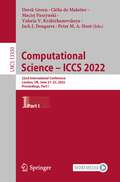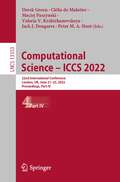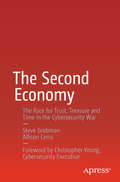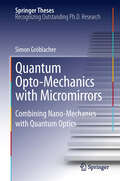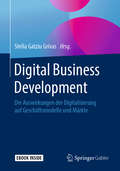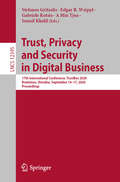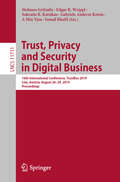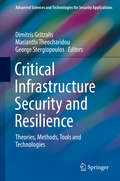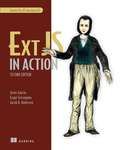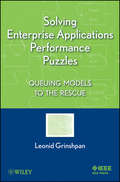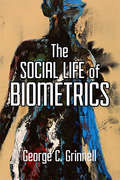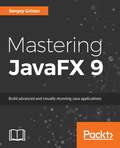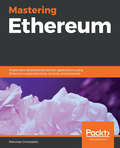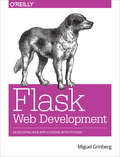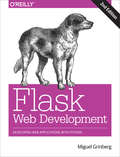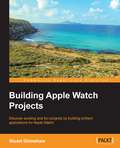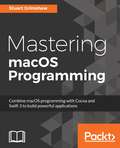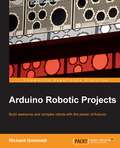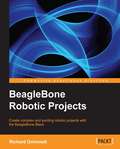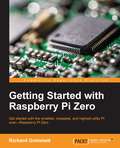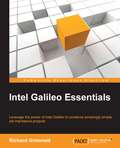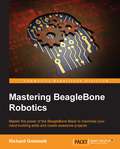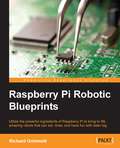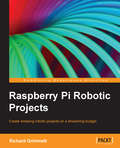- Table View
- List View
Computational Science – ICCS 2022: 22nd International Conference, London, UK, June 21–23, 2022, Proceedings, Part II (Lecture Notes in Computer Science #13351)
by Derek Groen Clélia De Mulatier Maciej Paszynski Valeria V. Krzhizhanovskaya Jack J. Dongarra Peter M. A. SlootThe four-volume set LNCS 13350, 13351, 13352, and 13353 constitutes the proceedings of the 22ndt International Conference on Computational Science, ICCS 2022, held in London, UK, in June 2022.* The total of 175 full papers and 78 short papers presented in this book set were carefully reviewed and selected from 474 submissions. 169 full and 36 short papers were accepted to the main track; 120 full and 42 short papers were accepted to the workshops/ thematic tracks. *The conference was held in a hybrid format
Computational Science – ICCS 2022: 22nd International Conference, London, UK, June 21–23, 2022, Proceedings, Part I (Lecture Notes in Computer Science #13350)
by Derek Groen Clélia De Mulatier Maciej Paszynski Valeria V. Krzhizhanovskaya Jack J. Dongarra Peter M. A. SlootThe four-volume set LNCS 13350, 13351, 13352, and 13353 constitutes the proceedings of the 22ndt International Conference on Computational Science, ICCS 2022, held in London, UK, in June 2022.* The total of 175 full papers and 78 short papers presented in this book set were carefully reviewed and selected from 474 submissions. 169 full and 36 short papers were accepted to the main track; 120 full and 42 short papers were accepted to the workshops/ thematic tracks. *The conference was held in a hybrid format
Computational Science – ICCS 2022: 22nd International Conference, London, UK, June 21–23, 2022, Proceedings, Part IV (Lecture Notes in Computer Science #13353)
by Derek Groen Clélia De Mulatier Maciej Paszynski Valeria V. Krzhizhanovskaya Jack J. Dongarra Peter M. A. SlootThe four-volume set LNCS 13350, 13351, 13352, and 13353 constitutes the proceedings of the 22ndt International Conference on Computational Science, ICCS 2022, held in London, UK, in June 2022.* The total of 175 full papers and 78 short papers presented in this book set were carefully reviewed and selected from 474 submissions. 169 full and 36 short papers were accepted to the main track; 120 full and 42 short papers were accepted to the workshops/ thematic tracks. *The conference was held in a hybrid format
The Second Economy
by Steve Grobman Allison CerraGain a practical prescription for both private and public organizations to remediate threats and maintain a competitive pace to lead and thrive in an ever-shifting environment. In today's hyper-connected, always-on era of pervasive mobility, cloud computing and intelligent connected devices, virtually every step we take, every transaction we initiate, and every interaction we have are supported in some way by this vast global infrastructure. This set of interconnected systems comprises the fundamental building blocks of the second economy - the very foundation of our first economy. And adversaries, whether motivated by profit, principle or province, are singularly focused on winning the race through a relentless portfolio of shifting attack vectors. Make no mistake about it, we are running a race. This is a race against a faceless, nameless adversary - one that dictates the starting line, the rules of the road, and what trophies are at stake. Established assumptions must be challenged, strategies must be revised, and long-held practices must be upended to run this race and effectively compete. The Second Economy highlights a second to none approach in this fight, as the effectiveness and ROI of security solutions are increasingly measured by the business outcomes they enable. What You Will Learn: Understand the value of time and trust in a cyber-warfare world Enable agile and intelligent organizations to minimize their risk of falling victim to the next attack Accelerate response time by adopting a holistic approach Eliminate friction across the threat defense lifecycle, from protection to detection to correction Gain a sustainable competitive advantage by seizing first mover advantage Deploy solutions across an open, integrated security framework Who This Book Is For: Senior-level IT decision makers concerned with ascribing business value to a robust security strategy. The book also addresses business decision makers who must be educated about the pervasive and growing cyber threatscape (including CXOs, board directors, and functional leaders) as well as general business employees to understand how they may become unwitting participants in a complex cyber war.
Quantum Opto-Mechanics with Micromirrors
by Simon GröblacherQuantum effects in macroscopic systems have long been a fascination for researchers. Over the past decade mechanical oscillators have emerged as a leading system of choice for many such experiments. The work reported in this thesis investigates the effects of the radiation-pressure force of light on macroscopic mechanical structures. The basic system studied is a mechanical oscillator that is highly reflective and part of an optical resonator. It interacts with the optical cavity mode via the radiation-pressure force. Both the dynamics of the mechanical oscillation and the properties of the light field are modified through this interaction. The experiments use quantum optical tools (such as homodyning and down-conversion) with the goal of ultimately showing quantum behavior of the mechanical center of mass motion. Of particular value are the detailed descriptions of several novel experiments that pave the way towards this goal and are already shaping the field of quantum optomechanics, in particular optomechanical laser cooling and strong optomechanical coupling.
Digital Business Development: Die Auswirkungen der Digitalisierung auf Geschäftsmodelle und Märkte
by Stella Gatziu GrivasWie werden im digitalen Zeitalter Geschäftsmodelle konzipiert, um die Entwicklung von Unternehmen voranzutreiben und die Positionierung im Markt zu stärken? Wie bereiten sich Unternehmen auf die neuen Geschäftsmöglichkeiten vor, um langfristig erfolgreich zu bleiben? Auf diese Fragen geht das Buch im Kontext der digitalen Transformation ein. Anschaulich beschrieben werden Change Management, Beispiele von Organisationsmodellen sowie Design Thinking, die das Digital Business Development ermöglichen. Dieses Buch verknüpft das Wissen von Fachexperten aus Praxis und Wissenschaft, die selbst viele Unternehmen begleitet haben. Business-Verantwortliche erfahren mehr über den gezielten Einsatz von technologischen Innovationen und IT-Verantwortlichen wird vermittelt, wie sie Ihre Rolle als Business Driver überzeugend wahrnehmen.
Trust, Privacy and Security in Digital Business: 17th International Conference, TrustBus 2020, Bratislava, Slovakia, September 14–17, 2020, Proceedings (Lecture Notes in Computer Science #12395)
by Stefanos Gritzalis Edgar R. Weippl Gabriele Kotsis A Min Tjoa Ismail KhalilThis book constitutes the refereed proceedings of the 17th International Conference on Trust, Privacy and Security in Digital Business, TrustBus 2020, held in Bratislava, Slovakia, in September 2020. The conference was held virtually due to the COVID-19 pandemic. The 11 full and 4 short papers presented were carefully reviewed and selected from 28 submissions. The papers are organized in the following topical sections: blockchain, cloud security/hardware; economics/privacy; human aspects; privacy; privacy and machine learning; trust.
Trust, Privacy and Security in Digital Business: 16th International Conference, TrustBus 2019, Linz, Austria, August 26–29, 2019, Proceedings (Lecture Notes in Computer Science #11711)
by Stefanos Gritzalis Edgar R. Weippl Sokratis K. Katsikas Gabriele Anderst-Kotsis A Min Tjoa Ismail KhalilThis book constitutes the refereed proceedings of the 16th International Conference on Trust, Privacy and Security in Digital Business, TrustBus 2019, held in Linz, Austria, in August 2019 in conjunction with DEXA 2019. The 11 full papers presented were carefully reviewed and selected from 24 submissions. The papers are organized in the following topical sections: privacy; and audit, compliance and threat intelligence.The chapter "A data utility-driven benchmark for de-identification methods" is open access under a CC BY 4.0 license at link.springer.com.
Critical Infrastructure Security and Resilience: Theories, Methods, Tools and Technologies (Advanced Sciences and Technologies for Security Applications)
by Dimitris Gritzalis Marianthi Theocharidou George StergiopoulosThis book presents the latest trends in attacks and protection methods of Critical Infrastructures. It describes original research models and applied solutions for protecting major emerging threats in Critical Infrastructures and their underlying networks. It presents a number of emerging endeavors, from newly adopted technical expertise in industrial security to efficient modeling and implementation of attacks and relevant security measures in industrial control systems; including advancements in hardware and services security, interdependency networks, risk analysis, and control systems security along with their underlying protocols.Novel attacks against Critical Infrastructures (CI) demand novel security solutions. Simply adding more of what is done already (e.g. more thorough risk assessments, more expensive Intrusion Prevention/Detection Systems, more efficient firewalls, etc.) is simply not enough against threats and attacks that seem to have evolved beyond modern analyses and protection methods.The knowledge presented here will help Critical Infrastructure authorities, security officers, Industrial Control Systems (ICS) personnel and relevant researchers to (i) get acquainted with advancements in the field, (ii) integrate security research into their industrial or research work, (iii) evolve current practices in modeling and analyzing Critical Infrastructures, and (iv) moderate potential crises and emergencies influencing or emerging from Critical Infrastructures.
Ext JS in Action
by Grgur Grisogono Jacob Andresen Jesus GarciaSummaryExt JS in Action, Second Edition teaches Ext JS from the ground up. You'll start with a quick overview of the framework and then explore the core components by diving into complete examples, engaging illustrations, and crisp, straightforward explanations. You'll feel like you have an expert guide right at your elbow teaching you important Ext techniques and offering insight into its inner workings. Along the way, you'll learn the best practices for building and scaling full-featured web applications, including how to customize and build Ext widgets. Fully revised for Ext JS 4.0.About this BookExt JS is a mature JavaScript web application framework that provides modern UI widgets and an advanced MVC architecture. It helps you manage tedious boilerplate and minimize hand-coded HTML and browser incompatibilities.Ext JS in Action, Second Edition starts with a quick overview of the framework and then explores the core components by diving into complete examples, engaging illustrations, and clear explanations. You'll feel like you have an expert guide at your elbow as you learn the best practices for building and scaling full-featured web applications.A working knowledge of JavaScript is assumed. No prior experience with Ext JS is required.Purchase of the print book includes a free eBook in PDF, Kindle, and ePub formats from Manning Publications.What's InsideBuilding professional web apps with Ext JSStamping out DOM fragments with templatesCustomizing and building Ext widgetsMasterful UI designFully revised for Ext JS version 4.0About the AuthorsJay Garcia is a well-known member of the Ext JS community and a contributor to the framework. He wrote Sencha Touch in Action. Grgur Grisogono founded SourceDevCon in London, UK and Split, Croatia. Jacob Andresen is a consultant specializing in large scale internet applications.Table of ContentsPART 1 INTRODUCTION TO EXT JS 4.0A framework apartDOM manipulationComponents and containersPART 2 EXT JS COMPONENTSCore UI componentsExploring layouts Forms in Ext JSThe data storeThe grid panelTaking root with treesDrawing and chartingRemote method invocation with Ext DirectDrag-and-dropPART 3 BUILDING AN APPLICATIONClass system foundationsBuilding an application
Solving Enterprise Applications Performance Puzzles
by Leonid GrinshpanPoorly performing enterprise applications are the weakest links in a corporation's management chain, causing delays and disruptions of critical business functions. This groundbreaking book frames enterprise application performance engineering not as an art but as applied science built on model-based methodological foundation. The book introduces queuing models of enterprise application that visualize, demystify, explain, and solve system performance issues. Analysis of these models will help to discover and clarify unapparent connections and correlations among workloads, hardware architecture, and software parameters.
The Social Life of Biometrics
by George C GrinnellIn The Social Life of Biometrics, biometrics is loosely defined as a discrete technology of identification that associates physical features with a legal identity. Author George Grinnell considers the social and cultural life of biometrics by examining what it is asked to do, imagined to do, and its intended and unintended effects. As a human-focused account of technology, the book contends that biometrics needs to be understood as a mode of thought that informs how we live and understand one another; it is not simply a neutral technology of identification. Placing our biometric present in historical and cultural perspective, The Social Life of Biometrics examines a range of human experiences of biometrics. It features individual stories from locations as diverse as Turkey, Canada, Qatar, Six Nations territory in New York State, Iraq, the skies above New York City, a university campus and Nairobi to give cultural accounts of identification and look at the ongoing legacies of our biometric ambitions. It ends by considering the ethics surrounding biometrics and human identity, migration, movement, strangers, borders, and the nature of the body and its coherence. How has biometric thought structured ideas about borders, race, covered faces, migration, territory, citizenship, and international responsibility? What might happen if identity was less defined by the question of “who’s there?” and much more by the question “how do you live?”
Mastering JavaFX 10: Build advanced and visually stunning Java applications
by Sergey GrinevDesign modern, rich interfaces for Java apps using JavaFX 10Key FeaturesLeverage advanced GUI programming techniques using the latest JavaFX 10 framework.Create dynamic content using the animation API and work with different application layersCreate and customize plugins and use them efficiently in different applicationsBook Description: JavaFX 10 is used to create media-rich client applications. This book takes you on a journey to use JavaFX 10 to build applications that display information in a high-performance, modern user interface featuring audio, video, graphics, and animation.Mastering JavaFX 10 begins by introducing you to the JavaFX API. You will understand the steps involved in setting up your development environment and build the necessary dependencies. This is followed by exploring how to work with the assets, modules, and APIs of JavaFX. This book is filled with practical examples to guide you through the major features of JavaFX 10. In addition to this, you will acquire a practical understanding of JavaFX custom animations, merging different application layers smoothly, and creating a user-friendly GUI with ease. By the end of the book, you will be able to create a complete, feature-rich Java graphical application using JavaFX.What you will learnConstruct and customize JavaFX windowsManage UI elements and arrange them on the SceneExplore the Bindings API and use it to coordinate various UI elementsUse FXML to design amazing FX applicationsWrite and manage CSS to style your applicationsAdd audio and video to your projectsPrepare your application to be launched on the target platformWho this book is forIf you’re a Java developer who wants to upgrade to the latest version of JavaFX to create stunning, feature-rich graphical applications, this book is for you. Some basic knowledge of Java programming is necessary to get the most out of this book. prior JavaFX knowledge will help but is not mandatory.
Mastering Ethereum: Implement advanced blockchain applications using Ethereum-supported tools, services, and protocols
by Merunas GrincalaitisAn expert guide to implementing fast, secure, and scalable decentralized applications that work with thousands of users in real timeKey FeaturesImplement advanced features of the Ethereum network to build powerful decentralized applicationsBuild smart contracts on different domains using the programming techniques of Solidity and VyperExplore the architecture of Ethereum network to understand advanced use cases of blockchain development Book DescriptionEthereum is one of the commonly used platforms for building blockchain applications. It's a decentralized platform for applications that can run exactly as programmed without being affected by fraud, censorship, or third-party interference.This book will give you a deep understanding of how blockchain works so that you can discover the entire ecosystem, core components, and its implementations. You will get started by understanding how to configure and work with various Ethereum protocols for developing dApps. Next, you will learn to code and create powerful smart contracts that scale with Solidity and Vyper. You will then explore the building blocks of the dApps architecture, and gain insights on how to create your own dApp through a variety of real-world examples. The book will even guide you on how to deploy your dApps on multiple Ethereum instances with the required best practices and techniques. The next few chapters will delve into advanced topics such as, building advanced smart contracts and multi-page frontends using Ethereum blockchain. You will also focus on implementing machine learning techniques to build decentralized autonomous applications, in addition to covering several use cases across a variety of domains such as, social media and e-commerce. By the end of this book, you will have the expertise you need to build decentralized autonomous applications confidently. What you will learnApply scalability solutions on dApps with Plasma and state channelsUnderstand the important metrics of blockchain for analyzing and determining its stateDevelop a decentralized web application using React.js and Node.jsCreate oracles with Node.js to provide external data to smart contractsGet to grips with using Etherscan and block explorers for various transactionsExplore web3.js, Solidity, and Vyper for dApps communicationDeploy apps with multiple Ethereum instances including TestRPC, private chain, test chain, and mainnetWho this book is forThis book is for anyone who wants to build fast, highly secure, and transactional decentralized applications. If you are an Ethereum developer looking to perfect your existing skills in building powerful blockchain applications, then this book is for you. Basic knowledge of Ethereum and blockchain is necessary to understand the concepts covered in this book.
Flask Web Development
by Miguel GrinbergTake full creative control of your web applications with Flask, the Python-based microframework. With this hands-on book, you'll learn Flask from the ground up by developing a complete social blogging application step-by-step. Author Miguel Grinberg walks you through the framework's core functionality, and shows you how to extend applications with advanced web techniques such as database migration and web service communication.Rather than impose development guidelines as other frameworks do, Flask leaves the business of extensions up to you. If you have Python experience, this book shows you how to take advantage of that creative freedom.Learn Flask's basic application structure and write an example appWork with must-have components--templates, databases, web forms, and email supportUse packages and modules to structure a large application that scalesImplement user authentication, roles, and profilesBuild a blogging feature by reusing templates, paginating item lists, and working with rich textUse a Flask-based RESTful API to expose app functionality to smartphones, tablets, and other third-party clientsLearn how to run unit tests and enhance application performanceExplore options for deploying your web app to a production server
Flask Web Development: Developing Web Applications with Python
by Miguel GrinbergTake full creative control of your web applications with Flask, the Python-based microframework. With the second edition of this hands-on book, you’ll learn the framework from the ground up by developing, step-by-step, a real-world project created by author Miguel Grinberg. This refreshed edition accounts for important technology changes that have occurred in the past three years.You’ll learn the framework’s core functionality, as well as how to extend applications with advanced web techniques such as database migration and web service communication. The first part of each chapter provides you with reference and background for the topic in question, while the second part guides you though a hands-on implementation of the topic.If you have Python experience, this book shows you how to take advantage of the creative freedom Flask provides.
Building Apple Watch Projects
by Stuart GrimshawDiscover exciting and fun projects by building brilliant applications for the Apple Watch About This Book * Explore the opportunities opened up to developers by Apple's latest device: the Apple Watch * Be a crackerjack at developing software across a broad range of watch app categories * From an eminent author, master all stages of development, from the first stage through to a completed project Who This Book Is For If you have some basic knowledge of programming in Swift and are looking for the best way to get started with Apple Watch development, this book is just the right one for you! What You Will Learn * Understand the concept of the Apple Watch as an autonomous device as well as it being paired with the iPhone * Get your app up and running * Design exciting, inspiring, and attractive layouts for your apps * Make your user interface more engaging using images and animation * Enable your Watch and iPhone apps to transport and share data * Leverage the feature-rich set of WatchKit technologies provided by Apple * Connect your apps to the Internet * Submit your app to the App Store In Detail With Apple's eagerly anticipated entry into the wearable arena, the field is wide open for a new era of app development. The Apple Watch is one of the most important technologies of our time. This easy-to-understand book takes beginners on a delightful journey of discovering the features available to the developer, right up to the completion of medium-level projects ready for App Store submission. It provides the fastest way to develop real-world apps for the Apple Watch by teaching you the concepts of Watch UI, visual haptic and audio, message and data exchange between watch and phone, Web communication, and finally Visual, haptic as well as audio feedback for users. By the end of this book, you will have developed at least four fully functioning apps for deployment on watchOS 2. Style and approach This is a step-by-step guide to developing apps for the Apple Watch with the help of screenshots and fully coded working examples.
Mastering macOS Programming
by Stuart GrimshawThis book is for developers who have some experience with macOS and want to take their skills to next level by unlocking the full potential of latest version of macOS with Swift 3 to build impressive applications. Basic knowledge of Swift will be beneficial but is not required.
Arduino Robotic Projects
by Richard GrimmettThis book is for anyone who has been curious about using Arduino to create robotic projects that were previously the domain of research labs of major universities or defense departments. Some programming background is useful, but if you know how to use a PC, you can, with the aid of the step-by-step instructions in this book, construct complex robotic projects that can roll, walk, swim, or fly.
BeagleBone Robotic Projects
by Richard GrimmettDevelop practical example projects with detailed explanations; combine the projects in a vast number of ways to create different robot designs, or work through them in sequence to discover the full capability of the BeagleBone Black.This book is for anyone who is curious about using new, low-cost hardware to create robotic projects that have previously been the domain of research labs, major universities or Defence departments. Some programming experience would be useful, but if you know how to use a personal computer, you can use this book to construct far more complex systems than you would have thought possible.
Getting Started with Raspberry Pi Zero
by Richard GrimmettGet started with the smallest, cheapest, and highest-utility Pi ever--Raspberry Pi Zero About This Book * Get started with Raspberry Pi Zero and put all of its exciting features to use * Create fun games and programs with little or no programming experience * Learn to use this super-tiny PC to control hardware and software for work, play, and everything else Who This Book Is For This book is for hobbyists and programmers who are taking their first steps toward using Raspberry Pi Zero. No programming experience is required, although some Python programming experience might be useful. What You Will Learn * Understand how to initially download the operating system and set up Raspberry Pi Zero * Find out how to control the GPIO pins of Raspberry Pi Zero to control LED circuits * Get to grips with adding hardware to the GPIO to control more complex hardware such as motors * Add USB control hardware to control a complex robot with 12 servos * Include speech recognition so that projects can receive commands * Enable the robot to communicate with the world around it by adding speech output * Control the robot from a distance and see what the robot is seeing by adding wireless communication * Discover how to build a Robotic hand and a Quadcopter In Detail Raspberry Pi Zero is half the size of Raspberry Pi A, only with twice the utility. At just three centimeters wide, it packs in every utility required for full-fledged computing tasks. This practical tutorial will help you quickly get up and running with Raspberry Pi Zero to control hardware and software and write simple programs and games. You will learn to build creative programs and exciting games with little or no programming experience. We cover all the features of Raspberry Pi Zero as you discover how to configure software and hardware, and control external devices. You will find out how to navigate your way in Raspbian, write simple Python scripts, and create simple DIY programs. Style and approach This is a practical and fun ?getting started? tutorial that will guide you through everything new that the Raspberry Pi has to offer.
Intel Galileo Essentials
by Richard GrimmettThis book is for anyone who has ever been curious about using the Intel Galileo to create electronics projects. Some programming background is useful, but if you know how to use a personal computer, with the aid of the step-by-step instructions in this book, you can construct complex electronics projects that use the Intel Galileo.
Mastering BeagleBone Robotics
by Richard GrimmettIf you want a simple guide to building complex robots, then this book is for you. You'll need some programming knowledge and experience working with mechanical systems.
Raspberry Pi Robotic Blueprints
by Richard GrimmettUtilize the powerful ingredients of Raspberry Pi to bring to life your amazing robots that can act, draw, and have fun with laser tagsAbout This BookLearn to implement a number of features offered by Raspberry Pi to build your own amazing robotsUnderstand how to add vision and voice to your robots.This fast-paced practical guide comprises a number of creative projects to take your Raspberry Pi knowledge to the next levelWho This Book Is ForThis all-encompassing guide was created for anyone who is interested in expanding their knowledge in applying the peripherals of Raspberry Pi. If you have a fancy for building complex-looking robots with simple, inexpensive, and readily available hardware, then this book is ideal for you. Prior understanding of Raspberry Pi with simple mechanical systems is recommended.What You Will LearnAdd sensors to your robot so that it can sense the world around itKnow everything there is to know about accessing motors and servos to provide movement to the robotic platformExplore the feature of adding vision to your robot so it can "see" the world around itRefine your robot with the skill of speech recognition so that it can receive commandsPolish your robot by adding speech output so it can communicate with the world around itMaximize the use of servos in Raspberry Pi to create a drawing robotStrengthen your robot by adding wireless communication skills so you can see what the robot is seeing and control it from a distanceBuild an unbelievable autonomous hexcopter controlled by Raspberry PiIn DetailThe Raspberry Pi is a series of credit card-sized single-board computers developed in the UK by the Raspberry Pi Foundation with the intention of promoting the teaching of basic computer science in schools. The Raspberry Pi is known as a tiny computer built on a single circuit board. It runs a Linux operating system, and has connection ports for various peripherals so that it can be hooked up to sensors, motors, cameras, and more. Raspberry Pi has been hugely popular among hardware hobbyists for various projects, including robotics.This book gives you an insight into implementing several creative projects using the peripherals provided by Raspberry Pi. To start, we'll walk through the basic robotics concepts that the world of Raspberry Pi offers us, implementing wireless communication to control your robot from a distance. Next, we demonstrate how to build a sensible and a visionary robot, maximizing the use of sensors and step controllers. After that, we focus on building a wheeled robot that can draw and play hockey. To finish with a bang, we'll build an autonomous hexcopter, that is, a flying robot controlled by Raspberry Pi.By the end of this book, you will be a maestro in applying an array of different technologies to create almost any imaginable robot.Style and approachThis book is an easy-to-follow, project-based guide that throws you directly into the action of creating almost any imaginable robot through blueprints. It is full of step by step instructions and screenshots to help you build amazing robots in no time at all.
Raspberry Pi Robotic Projects
by Richard GrimmettThis book is for enthusiasts who want to use Raspberry Pi to build complex robotics projects. However, some programming background is recommended. With the aid of the step-by-step instructions in this book, you can construct complex robotics projects that can move, talk, listen, see, swim, or fly. Raspberry Pi Robotic Projects is an easy-to-follow, step-by-step projects guide packed full of examples of actual robotics projects. Each topic is explained in detail to make it easy to replicate the projects described.
